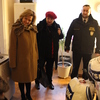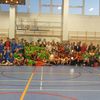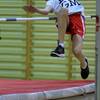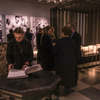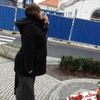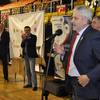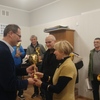Introduction
Milanówek - “Little London”
Walking along commemorative places of the World War II in Milanówek
Milanówek during the World War II was one of the most important headquarters, training centres and the area of continuous fight with the German invader in Western Mazovia region. The reason for that was its central location (only 30 km from Warsaw), favourable transport communications with the capital city (by PKP and EKD trains) as well as the fact that Milanówek’s prewar society mainly consisted of right-wing and centre-right Polish intellectuals, as well as many retired military men ( including several generals).
Patriotic education carried out by local schools and scout organization1 during the interwar period was crucial. Local community was well bound and integrated by participation in numerous social organizations such as: Milanowskie Towarzystwo Letnicze (Holidaymaker’s Society in Milanówek), Narodowa Organizacja Kobiet (Polish Wemen Organization), Towarzystwo Gimnastyczne „Sokół” (Gymnastics Society), Związek Strzelecki (Shooting Union), Legion Młodych (Youth Legion), Ochotnicza Straż Ogniowa (Voluntary Fire Brigade). Contribution of the parish house of St Jadwiga Śląska Church in Milanówek to engage local congregation in patriotic activity was also significant. At that time its parish priest prelate Walenty Zasada (ex-military man who finally became an army officer) was not only a scout chaplain but had also a considerable impact on patriotic education to young people in Milanówek.
The outbreak of the World War in 1939 wasn’t a surprise for Milanówek’s residents. In fact it had been expected since 1938 when the action of collecting weaponry and equipment for the Polish Army already started. People had been trained in civil defence: e.g. in gas and air raid protection etc. Gas masks had been sewn by local schools and organizations (filters were filled with activated carbon), food and fuel had been collected. Local units of anti aircraft defence had been formed. Alarms had been waiting in standby mode ready to sound. No wonder the whole Milanówek’s community mobilized immediately and rushed to fight against the invader from the very first day the war became the fact, the first bombs fell down and the first houses burnt, when first soldiers and innocent civilians were killed, when deportations to labour camps in German Reich and concentration camps started, when the war terror every week grew bigger and bigger. Many pro-independence organizations from Milanówek area such as Polska Organizacja Wojskowa (Polish Military Organization), Komenda Obrońców Polski (Poland Defenders Command), Narodowa Organizacja Wojskowa (National Military Organization), Narodowe Siły Zbrojne (National Armed Forces), Konfederacja Narodu (Confederation of the Polish Nation), at the beginning acting separately, started to unite and in 1942 established common front to fight with the invader – an organization called Związek Walki Zbrojnej – Armia Krajowa (Union for Armed Struggle – Home Army, abbreviated ZWZ-AK). Even though many people did not join ZWZ-AK structures directly, they were aware of the underground activity and supported their fight actively. Milanówek Unit („Mielizna”, „Pszczoła”) joined Błonie “Bażant” District (also called Grodzisk Mazowiecki District).
There were two special units of Kedyw (Directorate of Diversion) in Milanówek, three radio-stations for communication with London, service and security staff for three headquarters of different levels. Air drops were received, underground papers published, intelligence and counter-intelligence were operating, sabotage actions were arranged, Szare Szeregi (“Grey Ranks” – codename for the underground Polish Scouting Organization) were acting and underground education and cultural events were organized on a regular basis2. Of course such broad underground activity involved lots of victims, some of them were sent to Auschwitz or other concentration camps and never came back. Many Home Army soldiers were killed during military actions against Germans, almost 40 residents of Milanówek took part in the Warsaw Uprising.
Milanówek also played a significant role during the post-uprising period. According to the estimates, about 50-60 thousand fugitives from Warsaw made their way through the town. It was to Milanówek where 9 hospitals and 400-person orphanage were evacuated. Here they were provided with necessary help and medical assistance, food, clothing and accommodation for night.
Not only adults were involved in fighting. Youngsters and even children, brought up in the atmosphere of secret classes and military trainings carried out by Szare Szeregi or Wojskowa Służba Kobiet (Military Service for Women) were also getting ready for armed struggle.
During German occupation patriotic spirit shaped a strong front of fight for Polish culture, education and science. Underground teaching was organized on a vast scale to prevent Poland from civilization disaster that could have happened in case there were not enough high school educated people in the post-war country. Another forms of fight were Chopin’s concerts and Polish poetry soirees organized in private houses.
One cannot forget that the Metropolitan Warsaw Curia found its shelter and new location in the parish house of St Jadwiga’s Church in Milanówek, still before the Warsaw Uprising collapsed. The parish house was resided by Arc-bishop Antoni Szlagowski, who, brought in 1944, from burning Warsaw to Milanówek, the urn with Fryderyk Chopin’s heart and guarded it for over a year3. The presence of Arc-bishop Szlagowski as well as all above mentioned facts made local people even more motivated to fight and face new challenges which appeared after the headquarters of Western AK Sub-district was moved from Warsaw to Milanówek in 1944. There’s no doubt that it was a junction of the underground movement ties for the whole western Mazovia region.
For a short period of time following the collapse of the Warsaw Uprising Milanówek became an informal capital city of the Polish politics4. It was in Milanówek, where a considerable part of the Polish Underground State authorities found their shelter, where the Government Delegate’s offices were operating and important meetings of the representatives of different political organizations took place. Jan Nowak-Jeziorański, a wartime courier for the Polish Government-in-Exile in London and general Leopold Okulicki, the last AK Commander-in-Chief used to visit Milanówek. Milanówek was the seat of AK Warsaw Area Headquarters up to January 19455. The AK „Foto” Unit which, in collaboration with local photographers, prepared microfilms from the Government Delegate’s Office for the Polish Government in London was also transferred to Milanówek. No wonder Milanówek stared to be called “Little London” since that time. Another reason for that “nickname” could be the fact that a daily newspaper „Tu mówi Londyn” („Here’s London Speaking”), based on the BBC radio watch, was issued in Milanówek.
Soon after the soviet army had entered Milanówek, NKWD (Soviet Union Secret Police) and UB6(Security Department) started massive arresting to AK soldiers, which continued until 1956. The arrested were then deported to the NKWD concentration camp in Rembertów, to prisons in Rawicz and Wronki or inside the USRR.
*
The readers of this informative brochure are invited for a walk, following traces of the World War II in Milanówek. There are lots of such “traces” and therefore we had to reduce our walking route to the most significant ones. They have been numbered and marked on the city map. Pictures of some memorials and villas as well as short descriptions of their roles during the war have been included in order to make their identification during the walk easier. Bibliography of the main publications on Milanówek of the war period has been put at the end of this short guide to broaden your knowledge about heroic events of that time. The guide does not suggest any specific sequence of visiting places, you can chose freely the route and those considered worth seeing.
Developed by Andrzej Pettyn
Footnotes
- Marian Hassa „Harcerstwo polskie w Milanówku”, part. I, TMM 2001.
- Stefan Jaczewski “Tajne nauczanie w Milanówku”, in: “Kiedy Milanówek był stolicą...", Milanówek 2000 r. Andrzej Stawarz (red.) „Zarys dziejów Milanówka”, Milanówek 1995
- Andrzej Pettyn „Gdzie skarb twój, tam i serce twoje” (in: „Kiedy Milanówek był stolicą…”, 2000)
- Marian Podkowiński “Kiedy Milanówek był stolicą...”, “Stolica” nr 3, 1975
- Magdalena Grochowska “Złota łyżeczko, żegnaj! – Polskie Państwo Podziemne”, “Życie Warszawy”, 27.07.1994
- Mieczysław Fastyn "...Całym życiem służyć Bogu i Polsce..." (in: quarterly "Milanówek" No 3/1999).
 Wersja do druku
Wersja do druku
